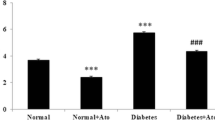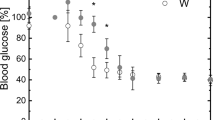Abstract
Increasing evidence shows that the overproduction of reactive oxygen species, induced by diabetic hyperglycemia, contributes to the development of several cardiopathologies. The susceptibility of diabetic hearts to oxidative stress, induced in vitro by ADP-Fe2+ in mitochondria, was studied in 12-month-old Goto-Kakizaki rats, a model of non-insulin dependent diabetes mellitus, and normal (non-diabetic) Wistar rats. In terms of lipid peroxidation the oxidative damage was evaluated on heart mitochondria by measuring both the O2 consumption and the concentrations of thiobarbituric acid reactive substances. Diabetic rats display a more intense formation of thiobarbituric acid reactive substances and a higher O2 consumption than non-diabetic rats. The oxidative damage, assessed by electron microscopy, was followed by an extensive effect on the volume of diabetic heart mitochondria, as compared with control heart mitochondria. An increase in the susceptibility of diabetic heart mitochondria to oxidative stress can be explained by reduced levels of endogenous antioxidants, so we proceeded in determinating α-tocopherol, GSH and coenzyme Q content. Although no difference of α-tocopherol levels was found in diabetic rats as compared with control rat mitochondria, a significant reduction in GSH (21.5% reduction in diabetic rats) and coenzyme Q levels of diabetic rats was observed. The data suggest that a significant decrease of coenzyme Q9, a potent antioxidant involved in the elimination of mitochondria-generated reactive oxygen species, may be responsible for an increased susceptibility of diabetic heart mitochondria to oxidative damage.
Similar content being viewed by others
References
Groop LC: The molecular genetics of non-insulin-dependent diabetes mellitus. J Intern Med 241: 95-101, 1997
Ren J, Davidoff AJ: Diabetes rapidly induces contractile dysfunctions in isolated ventricular myocytes. Am J Physiol 272: H148-H158, 1997
Feuvray D, Lopaschuk GD: Controversies on the sensitivity of diabetic heart to ischemic injury: The sensitivity of the diabetic heart to ischemic injury is decreased. Cardiovasc Res 34: 113-120, 1997
Paulson DJ: The diabetic heart is more sensitive to ischemic injury. Cardiovasc Res 34: 104-112, 1997
Luft R: The development of mitochondrial medicine. Biochim Biophys Acta 1271: 1-6, 1995
Momiyama Y, Atsumi Y, Ohsuzu F, Ui S, Morinaga S, Matsuoka, Kimura M: Rapid progression of cardiomyopathy in mitochondrial diabetes. Jpn Circ J 63: 130-132, 1999
Schmidt AM, Stern D: A radical approach to the pathogenesis of diabetic complications. Trends Pharmacol Sci 21: 367-369, 2000
Palmeira CM, Ferreira FM, Santos DL, Ceiça R, Suzuki K, Santos MS: Higher efficiency of the liver phosphorylative system in diabetic Goto-Kakizaki (GK) rats. FEBS Lett 458: 103-106: 1999
Halliwell B, Gutteridge JMC: Free Radicals in Biology and Medicine, 3rd Edit. Oxford University Press, Oxford, 1999
Kowaltowski AJ, Vercesi AE: Mitochondrial damage induced by conditions of oxidative stress. Free Radic Biol Med 26: 463-471, 1999
Chance B, Sies H, Boveris A: Hydroperoxide metabolism in mammalian organs. Physiol Rev 59: 527-605, 1979
Reinheckel T, Wiswedel I, Noack H, Augustin W: Electrophoretic evidence for the impairment of complexes of the respiratory chain during iron/ascorbate induced peroxidation in isolated rat liver mitochondria. Biochim Biophys Acta 1239: 45-50, 1995
Marshansky VN, Novgorodov SA, Yaguzhinsky LS: The role of lipid peroxidation in the induction of cation transport in rat liver mitochondria. The antioxidant effect of oligomycin and dicyclohexylcarbodiimide. FEBS Lett 158: 27-30, 1983
Carbonera D, Azzone GF: Permeability of inner mitochondrial membrane and oxidative stress. Biochim Biophys Acta 943: 245-255, 1988
Baynes JW, Thorpe SR: Role of oxidative stress in diabetic complications: A new perspective on an old paradigm. Diabetes 48: 1-9, 1999
Scholz RW, Minicucci LA, Reddy CC: Effects of vitamin E and selenium on antioxidant defense in rat heart. Biochem Mol Biol Int 42: 997-1006, 1997
Kagan VE, Serbinova E, Packer L: Antioxidant effects of ubiquinone in microsomes and mitochondria are mediated by tocopherol recycling. Biochem Biophys Res Commun 169: 851-857, 1990
Ernster L, Dallner G: Biochemical, physiological and medical aspects of ubiquinone function. Biochim Biophys Acta 1271: 195-204, 1995
Rauchova H, Lenaz G: Coenzyme Q and its therapeutics used. Cezka Slov Farm 50: 78-82, 2001
Goto Y, Kakizaki M: The spontaneous diabetic rat: A model of non-insulin dependent diabetes mellitus. Proc Jpn Acad 57: 381-384, 1981
Cain K, Skilleter, DN: Preparation and use of mitochondria in toxicological research. In: K. Snell, B. Mullock (eds). Biochemical Toxicology — A Practical Approach. IRL Press, Washington, DC, 1987, pp 217-254
Gornall AG, Bardawill CJ, David MM: Determination of serum proteins by means of the biuret reaction. J Biol Chem 177: 751-766, 1949
Sassa H, Takaishi Y, Terada H: The triterpene celastrol as a very potent inhibitor of lipid peroxidation in mitochondria. Biochem Biophys Res Commun 172: 890-897, 1990
Ernster L, Nordenbrand K: Microsomal lipid peroxidation. Meth Enzymol 10: 574-580, 1967
Buege JA, Aust S: Microsomal lipid peroxidation. Meth Enzymol 52: 302-310, 1978
Takada M, Ikenoya S, Yuzuriha T, Katayama K: Simultaneous determination of reduced and oxidized ubiquinones. Meth Enzymol 105: 147-155, 1984
Chung AP, Rainey F, Nobre MF, Burghardt J, Costa MS: Meiothermus cerbereus sp.nov., a new slightly thermophilic species with high levels of 3-hydroxy fatty acids. Int J System Bacter 47: 1225-1230, 1997
Vatassery GT, Morley JE, Kuskowski MA: Vitamin E in plasma and platelets of human diabetic patients and control subjects. Am J Clin Nutr 37: 641-644, 1983
Hissin PJ, Hilf R: A fluorometric method for determination of oxidized and reduced glutathione in tissues. Anal Biochem 74: 214-226, 1976
Weibel ER: In: M.A. Hayat (ed). Principles and Techniques of Electron Microscopy: Biological Applications. Van Nostrand Reinhold, New York, 1973
Agardh CD, Agardh E, Hultberg B, Qian Y, Ostenson CG: The glutathione levels are reduced in Goto-Kakizaki rat retina, but are not influenced by aminoguanidine treatment. Curr Eye Res 17: 251-256, 1998
Wolff SP, Dean RT: Glucose autoxidation and protein modification: The potential role of autoxidative glycosylation in diabetes. Biochem J 245: 243-250, 1987
Oberley LW: Free radicals and diabetes. Free Radic Biol Med 5: 113-124, 1988
Baynes JW: Role of oxidative stress in development of complications in diabetes. Diabetes 40: 405-412, 1991
Mullarkey CJ, Edelstein D, Brownlee M: Free radical generation by early glycation products: A mechanism for accelerated atherogenesis in diabetes. Biochem Biophys Res Commun 173: 932-939, 1990
Sukalski KA, Pinto KA, Berntson JL: Decreased susceptibility of liver mitochondria from diabetic rats to oxidative damage and associated increase in alpha-tocopherol. Free Radic Biol Med 14: 57-65, 1993
Jain SK, Palmer M: The effect of oxygen radicals metabolites and vitamin E on glycosylation of proteins. Free Radic Biol Med 22: 593-596, 1997
Aguirre F, Martin I, Grinspon D, Ruiz M, Hager A, De Paoli T, Ihlo J, Farach HA, Poole CP Jr: Oxidative damage, plasma antioxidant capacity, and glucemic control in elderly NIDDM patients. Free Radic Biol Med 24: 580-585, 1998
Daum G: Lipids of mitochondria. Biochim Biophys Acta 822: 1-42, 1985
Werns SW, Lucchesi BR: Free radicals and ischemic tissue injury. Trends Pharmacol Sci 11: 161-166, 1990
Wallace KB: Free radical-mediated chemical cardiomiopathies. In: K. Wallace (ed). Free Radical Toxicology. Taylor and Francis, Washington, DC, 1997, pp 205-219
Ferreira FM, Palmeira CM, Matos MJ, Seiça R, Santos MS: Decreased susceptibility to lipid peroxidation of Goto-Kakizaki rats: Relationship to mitochondrial antioxidant capacity. Life Sci 65: 1013-1025, 1999
Choliparambil KP, Subramanian M, Devasagayam PA, Singh BB: Study on lipid peroxidation potential in different tissues induced by ascorbate-Fe2+: Possible factors involved in their differential susceptibility. Mol Cell Biochem 178: 197-202, 1998
Beyer RE: The participation of coenzyme Q in free radical production and antioxidation. Free Radic Biol Med 8: 545-565, 1990
Lass A, Sohal RS: Electron transport-linked ubiquinone-dependent recycling of alpha-tocopherol inhibits autooxidation of mitochon-drial membranes. Arch Biochem Biophys 352: 229-236, 1998
Forsmark P, Aberg F, Norling B, Nordenbrand K, Dallner G, Ernster L: Inhibition of lipid peroxidation by ubiquinol in submitochondrial particles in the absence of vitamin E. FEBS Lett 285: 39-43, 1991
Kagan VE, Packer L: Antioxidants: Function of vitamin E and ubiquinols. In: Methods in Toxicology, Vol. 2. Academic Press, New York, 1993, pp 277-285
Stoyanovsky DA, Osipov AN, Quinn PJ, Kagan VE: Ubiquinone-dependent recycling of vitamin E radicals by superoxide. Arch Biochem Biophys 323: 343-351, 1995
Kucharska J, Braunova Z, Ulicna O, Zlatos L, Gvozdjakova A: Deficit of coenzyme Q in heart and liver mitochondria of rats with streptozotocin-induced diabetes. Physiol Res 49: 411-418, 2000
Santos MS, Santos DL, Palmeira CM, Seiça R, Moreno AJ, Oliveira CR: Brain and liver mitochondria isolated from diabetic Goto-Kakizaki rats show different susceptibility to induced oxidative stress. Diabetes Metab Res Rev 17: 223-230, 2001
Author information
Authors and Affiliations
Rights and permissions
About this article
Cite this article
Santos, D.L., Palmeira, C.M., Sei%ccedil;a, R. et al. Diabetes and mitochondrial oxidative stress: A study using heart mitochondria from the diabetic Goto-Kakizaki rat. Mol Cell Biochem 246, 163–170 (2003). https://doi.org/10.1023/A:1023475022025
Issue Date:
DOI: https://doi.org/10.1023/A:1023475022025




